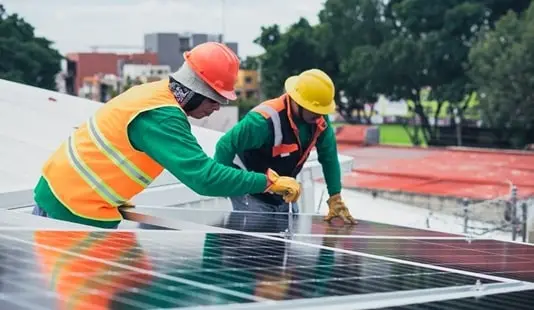Are soaring electricity bills and environmental concerns pushing you to consider solar energy for your home?
As the renewable energy industry continues to grow, more and more homeowners are turning to solar panels to power their homes. And if you have a flat tile roof, you may be wondering if it’s a suitable option for solar panel installation.
Before making any decisions, it’s essential to consider various factors that could impact the performance and success of your solar panels. So, let’s dive in!

1. Weight of the Panels
Flat tile roofs are designed to support the weight of the tiles themselves, along with natural elements such as rain or snow. Yet, adding the weight of solar panels can put extra stress on the structure of the roof. It is essential to consult with a professional to ensure that the roof can support the added weight.
Failure to do so can result in damage to the roof and potential safety hazards. The weight of the panels must be considered to ensure a successful installation and the longevity of the roof.
2. Orientation and Angle of the Roof
The roof orientation refers to the direction it faces. This will determine how much sunlight the panels will receive throughout the day. South-facing roofs are generally considered the most optimal for the greatest sunlight exposure.
The angle of the roof, also known as the tilt, is another important factor. The ideal tilt for solar panels varies depending on location and can affect their efficiency.
Properly orienting and angling solar panels can impact their energy production. This makes it essential to carefully assess these factors before installation.
3. Roof Age
A roof’s age is crucial as it impacts the structural integrity and durability of the roof. If a roof is reaching the end of its lifespan, it may not be able to support the extra weight of solar panels.
This may lead to costly repairs or even collapse. It’s essential to have a professional assess the roof’s age and condition before proceeding with solar panel installation. In turn, this ensures a safe and long-lasting investment.
4. Type of Solar Panels
There are two main types of solar panels – photovoltaic (PV) and thermal solar panels. PV panels convert sunlight into electricity while thermal panels use the sun’s heat to warm up water or air.
Additionally, the material and design of the solar panels should be taken into consideration as they can affect the efficiency and durability of the system. It is crucial to research and select the type of solar panels that best fit the unique conditions of your flat tile roof.
5. Shading
Shading refers to the blocking of sunlight on certain areas of the roof, which can affect the efficiency of the solar panels. If your roof is surrounded by tall trees or buildings or has overhanging structures such as chimneys or skylights, it may result in shade during certain times of the day.
This shade can reduce the amount of sunlight that reaches the solar panels, thus decreasing their energy production. It is crucial to assess the shading situation before deciding on the placement of solar panels on a flat tile roof to ensure the greatest efficiency.
6. Maintenance
Solar panels need regular maintenance to ensure they operate efficiently and remain in good condition. In the case of a flat tile roof, this can be more challenging compared to a pitched roof. The flat surface may accumulate debris and dirt, which can hinder the panels’ performance.
Additionally, the tiles may need to be removed and reinstalled during maintenance, which can be a time-consuming and delicate process. It is important to factor in the accessibility and cost of maintenance when considering the installation of solar panels on a flat tile roof.
7. Local Climate
The climate of an area can greatly impact the efficiency and effectiveness of solar panels. For instance, areas with high levels of sunlight will generate more energy from solar panels compared to areas with frequent cloudy or rainy weather.
Also, extreme temperature variations can affect the lifespan of solar panels, making it necessary to choose panels that are suitable for the local climate. Additionally, considering the local climate can help determine the need for extra precautions, such as insurance or maintenance, to ensure the long-term success of solar panels on a flat tile roof.
8. Government Incentives
These incentives, offered as tax credits or rebates, can reduce the initial costs of installation and make solar energy more affordable for homeowners. Before investing, it is essential to research and consider the government incentives available in your area. Some states and municipalities offer generous incentives, while others have minimal or no incentives at all.
Additionally, these incentives can vary depending on the size and type of solar panel installation. Understanding and taking advantage of government incentives can make a significant difference in the long-term savings and benefits of installing solar panels on a flat tile roof.
9. Return on Investment
Installing solar panels on a flat tile roof can be a significant investment, which is why it is important to consider the return on investment before making a decision. This factor takes into account the initial cost of installation, as well as the savings from reduced energy bills and potential tax incentives. It is also important to consider the lifespan and maintenance costs of the solar panels, as well as the potential increase in property value.
With the right installation process and services, the return on investment for solar panels on a flat tile roof can be significant in the long run. So, click for more information about the installation process and services available to ensure a successful and profitable investment in solar energy.
10. Ultimate Reasons to Install Solar Panels on a Flat Tile Roof
Installing solar panels on a flat tile roof is a significant investment with long-term benefits. It is crucial to consider factors such as weight-bearing capacity, weather conditions, and the expertise of a professional installer before making a decision.
With careful planning and consideration, solar panels can provide clean and sustainable energy for years to come. Don’t hesitate to consult a specialist and start your journey towards a greener and more cost-effective home today!
Looking for more tips and advice? You’re in the right place! Make sure to bookmark our page and come back to check out more interesting articles.
Satyakam Pradhan is an Independent Computer Networking Professional from Cuttack, Odisha, India. Satyakam completed his graduation from Bhubanananda Orissa School Of Engineering. He regularly writes topics about technology, gadgets and computer for IndiasStuffs.com
Page Contents

